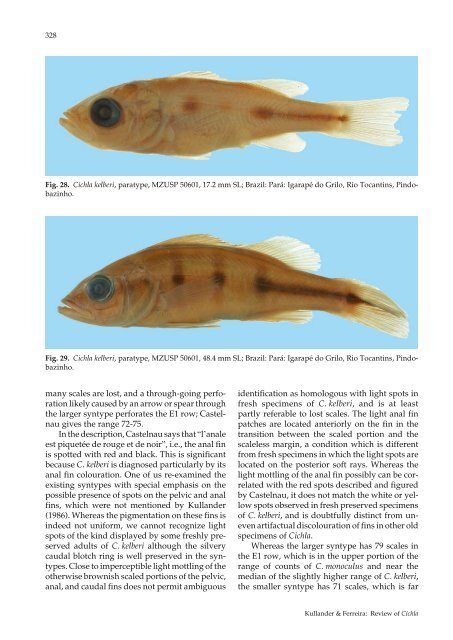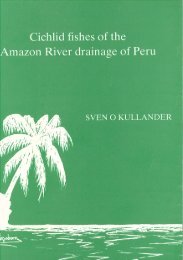Open Access PDF - Sven Kullander
Open Access PDF - Sven Kullander
Open Access PDF - Sven Kullander
Create successful ePaper yourself
Turn your PDF publications into a flip-book with our unique Google optimized e-Paper software.
328<br />
Fig. 28. Cichla kelberi, paratype, MZUSP 50601, 17.2 mm SL; Brazil: Pará: Igarapé do Grilo, Rio Tocantins, Pindobazinho.<br />
Fig. 29. Cichla kelberi, paratype, MZUSP 50601, 48.4 mm SL; Brazil: Pará: Igarapé do Grilo, Rio Tocantins, Pindobazinho.<br />
many scales are lost, and a through-going perforation<br />
likely caused by an arrow or spear through<br />
the larger syntype perforates the E1 row; Castelnau<br />
gives the range 72-75.<br />
In the description, Castelnau says that “l’anale<br />
est piquetée de rouge et de noir”, i.e., the anal fin<br />
is spotted with red and black. This is significant<br />
because C. kelberi is diagnosed particularly by its<br />
anal fin colouration. One of us re-examined the<br />
existing syntypes with special emphasis on the<br />
possible presence of spots on the pelvic and anal<br />
fins, which were not mentioned by <strong>Kullander</strong><br />
(1986). Whereas the pigmentation on these fins is<br />
indeed not uniform, we cannot recognize light<br />
spots of the kind displayed by some freshly preserved<br />
adults of C. kelberi although the silvery<br />
caudal blotch ring is well preserved in the syntypes.<br />
Close to imperceptible light mottling of the<br />
otherwise brownish scaled portions of the pelvic,<br />
anal, and caudal fins does not permit ambiguous<br />
identification as homologous with light spots in<br />
fresh specimens of C. kelberi, and is at least<br />
partly referable to lost scales. The light anal fin<br />
patches are located anteriorly on the fin in the<br />
transition between the scaled portion and the<br />
scaleless margin, a condition which is different<br />
from fresh specimens in which the light spots are<br />
located on the posterior soft rays. Whereas the<br />
light mottling of the anal fin possibly can be correlated<br />
with the red spots described and figured<br />
by Castelnau, it does not match the white or yellow<br />
spots observed in fresh preserved specimens<br />
of C. kelberi, and is doubtfully distinct from uneven<br />
artifactual discolouration of fins in other old<br />
specimens of Cichla.<br />
Whereas the larger syntype has 79 scales in<br />
the E1 row, which is in the upper portion of the<br />
range of counts of C. monoculus and near the<br />
median of the slightly higher range of C. kelberi,<br />
the smaller syntype has 71 scales, which is far<br />
<strong>Kullander</strong> & Ferreira: Review of Cichla




